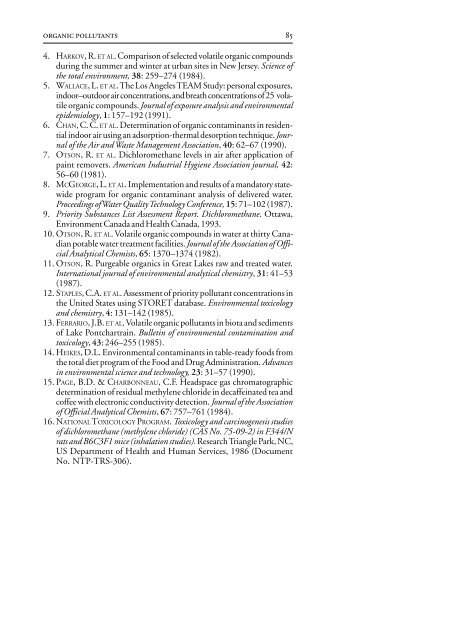Air Quality Guidelines - World Health Organization Regional Office ...
Air Quality Guidelines - World Health Organization Regional Office ...
Air Quality Guidelines - World Health Organization Regional Office ...
Create successful ePaper yourself
Turn your PDF publications into a flip-book with our unique Google optimized e-Paper software.
organic pollutants<br />
4. HARKOV, R. ET AL. Comparison of selected volatile organic compounds<br />
during the summer and winter at urban sites in New Jersey. Science of<br />
the total environment, 38: 259–274 (1984).<br />
5. WALLACE, L. ET AL. The Los Angeles TEAM Study: personal exposures,<br />
indoor–outdoor air concentrations, and breath concentrations of 25 volatile<br />
organic compounds. Journal of exposure analysis and environmental<br />
epidemiology, 1: 157–192 (1991).<br />
6. CHAN, C. C. ET AL. Determination of organic contaminants in residential<br />
indoor air using an adsorption-thermal desorption technique. Journal<br />
of the <strong>Air</strong> and Waste Management Association, 40: 62–67 (1990).<br />
7. OTSON, R. ET AL. Dichloromethane levels in air after application of<br />
paint removers. American Industrial Hygiene Association journal, 42:<br />
56–60 (1981).<br />
8. MCGEORGE, L. ET AL. Implementation and results of a mandatory statewide<br />
program for organic contaminant analysis of delivered water.<br />
Proceedings of Water <strong>Quality</strong> Technology Conference, 15: 71–102 (1987).<br />
9. Priority Substances List Assessment Report. Dichloromethane. Ottawa,<br />
Environment Canada and <strong>Health</strong> Canada, 1993.<br />
10. OTSON, R. ET AL. Volatile organic compounds in water at thirty Canadian<br />
potable water treatment facilities. Journal of the Association of Official<br />
Analytical Chemists, 65: 1370–1374 (1982).<br />
11. OTSON, R. Purgeable organics in Great Lakes raw and treated water.<br />
International journal of environmental analytical chemistry, 31: 41–53<br />
(1987).<br />
12. STAPLES, C.A. ET AL. Assessment of priority pollutant concentrations in<br />
the United States using STORET database. Environmental toxicology<br />
and chemistry, 4: 131–142 (1985).<br />
13. FERRARIO, J.B. ET AL. Volatile organic pollutants in biota and sediments<br />
of Lake Pontchartrain. Bulletin of environmental contamination and<br />
toxicology, 43: 246–255 (1985).<br />
14. HEIKES, D.L. Environmental contaminants in table-ready foods from<br />
the total diet program of the Food and Drug Administration. Advances<br />
in environmental science and technology, 23: 31–57 (1990).<br />
15. PAGE, B.D. & CHARBONNEAU, C.F. Headspace gas chromatographic<br />
determination of residual methylene chloride in decaffeinated tea and<br />
coffee with electronic conductivity detection. Journal of the Association<br />
of Official Analytical Chemists, 67: 757–761 (1984).<br />
16. NATIONAL TOXICOLOGY PROGRAM. Toxicology and carcinogenesis studies<br />
of dichloromethane (methylene chloride) (CAS No. 75-09-2) in F344/N<br />
rats and B6C3F1 mice (inhalation studies). Research Triangle Park, NC,<br />
US Department of <strong>Health</strong> and Human Services, 1986 (Document<br />
No. NTP-TRS-306).<br />
85

















